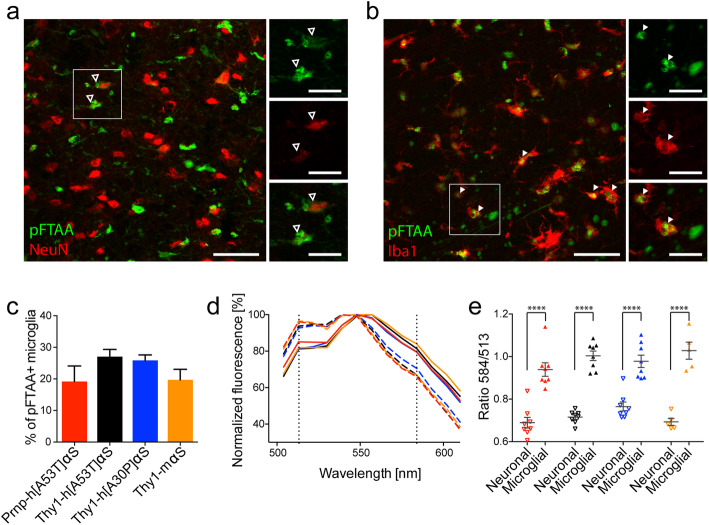Fig. 2.
Distinct pFTAA-positive inclusions in neurons and microglia of symptomatic αS TG mice. (a) Fluorescence double-staining for pFTAA (green) and NeuN (red) of brainstem pathology in Thy1-h[A30P]αS. Examples of neuronal pFTAA-positive inclusions around the nuclei are shown (arrowhead outlines). Scale bars, 50 μm and 20 μm (inserts). (b) Fluorescence double-staining for pFTAA (green) and Iba1 (red) of brainstem pathology in Thy1-h[A30P]αS. Examples of microglial pFTAA-positive inclusions are shown (arrowheads). Scale bars, 50 μm and 20 μm (inserts). (c) The percentage of microglia containing pFTAA-positive inclusions for all mouse lines. The proportion of pFTAA-/Iba1-double-positive cells was not significantly different between the lines (n = 3 mice per line). Results are expressed as mean ± SEM. (d, e) Spectral analysis of pFTAA-positive inclusions in neurons and microglia. (d) Mean emission spectra of NeuN-positive (dotted lines) and Iba1-positive (solid lines) deposits in Prnp-h[A53T]αS (red, n = 8), Thy1-h[A53T]αS (black, n = 8), Thy1-h[A30P]αS (blue, n = 8), and Thy1-mαS (orange, n = 5). Vertical black dotted lines represent the first peak and the shoulder of pFTAA spectra at wavelengths of 513 and 584 nm, respectively. (e) The ratio of emission intensity at wavelengths 513 and 584 nm calculated to show the spectral shift of pFTAA upon binding to neuronal (empty triangles) and microglial (solid triangles) inclusions in Prnp-h[A53T]αS (red, n = 8), Thy1-h[A53T]αS (black, n = 8), Thy1-h[A30P]αS (blue, n = 8), and Thy1-mαS (orange, n = 5). Two-way ANOVA (cell type x mouse line) revealed a significant effect for cell type [F(1,50) = 218, ****P < 0.0001], but not for mouse line [F(3,50) = 2.156, P = 0.1049] or interaction between cell type and mouse line [F(3,50) = 1.842, P = 0.1516]. The results are expressed as mean ± SEM

